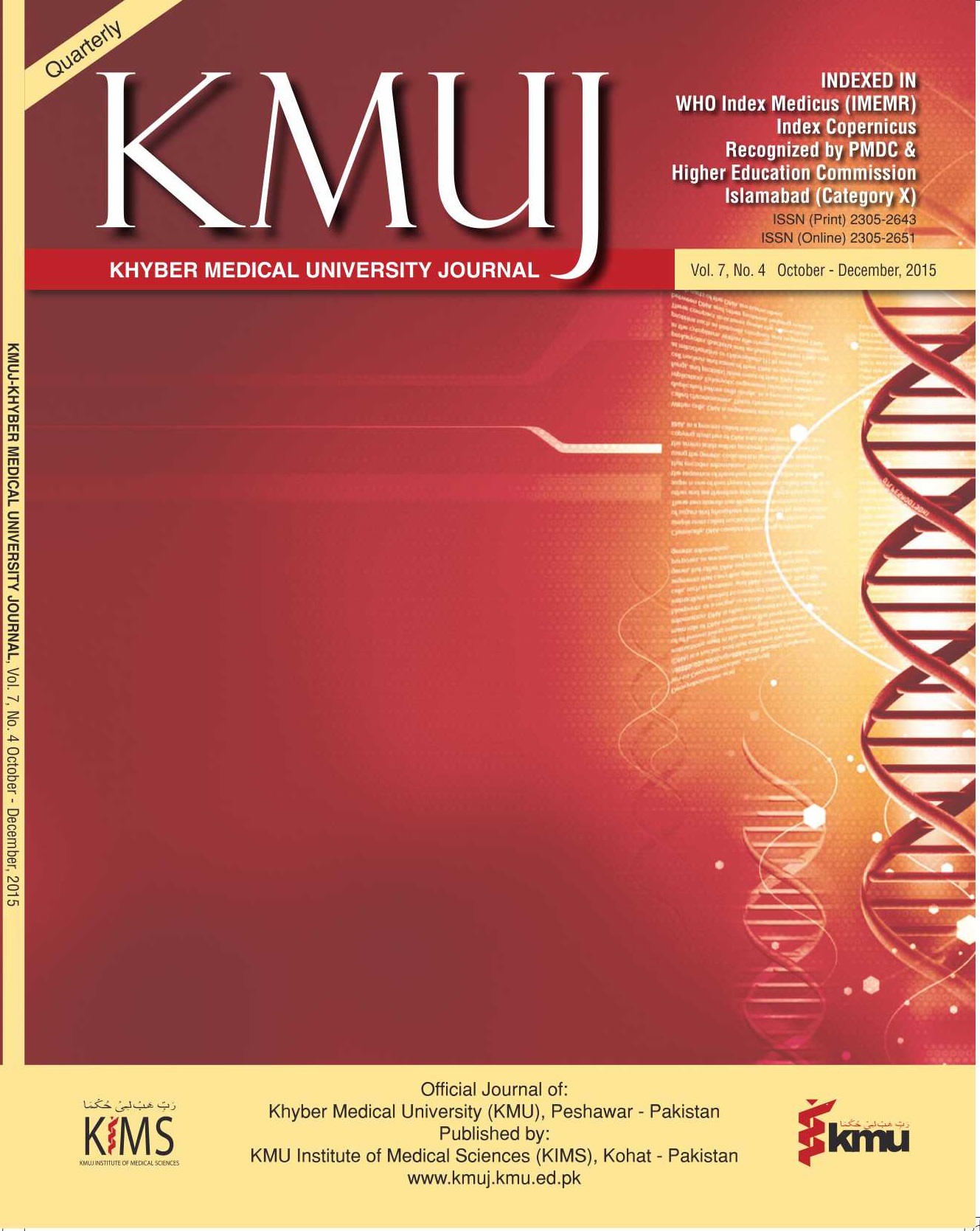Risk Factors of Pre-Eclampsia/Eclampsia and Its Adverse Outcomes in Low- and Middle-Income Families
Main Article Content
Abstract
ABSTRACT
Objective: to identify the socio-demographic and other risk factors associated with pre-eclampsia, eclampsia and its adverse outcomes in low- and middle-income pregnant females.
Methods: This cross-sectional study was conducted at three tertiary care hospitals of Peshawar Pakistan, on 113 pregnant women (43 with pre-eclampsia, 37 with eclampsia and 33 without pre-eclampsia/eclampsia). Data was collected by interviewing study subjects using a pre-tested questionnaire incorporating important risk factors of pre-eclampsia and eclampsis. Data was analyzed using SPSS.
Results: Majority (89.4%) of women were >20 years of age. Out of 113 study participants, 78(69.02%) were from low-income (Rs<8500) and 35 (30.98%) were from middle-income (Rs= 8501-103900) group. Thirty one (83.78%) patients of eclamptia, 32 (74.42%) of pre-eclampsia and 15 (45.45%) normotensive pregnant women were from low-income group (p<0.01). Forty-nine of 113 (43.3%) antenatal women had no antenatal visits and 48 (42.5%) had 1-3 antenatal visits. About half of women with low-income (n=40/78, 51.3%) had no antenatal visits as compared to middle-income (n=9/36; 25.7%). Out of 49 women with no antenatal visits, 23 (46.94%) were eclamptic, 25 (51.02%) were having pre-eclampsia and 1 (2.04%) was normotensive. In this study, 23/37 (62.26%) of eclampsia, 25/43 (58.14%) of pre-eclampsia and 1/33 (3.03%) of normotensive pregnant women had no antental visits. Twenty (17.7%) antenatal women had history of >2 still-births and majority (n=16/20; 80%) were from low-income group.
Conclusion: Lower class socio-economic status and lack of antenatal visit are associated with pre-eclampsia and eclampsia and related adverse outcome. Interventions at primary care level are in need.
Keywords: Pregnancy Outcome (MeSH), Eclampsia (MeSH), Pre-eclampsia (MeSH), Pregnancy (MeSH), Hypertension (MeSH), Low Income Population (MeSH), Poverty (MeSH)
Article Details
Work published in KMUJ is licensed under a
Creative Commons Attribution 4.0 License
Authors are permitted and encouraged to post their work online (e.g., in institutional repositories or on their website) prior to and during the submission process, as it can lead to productive exchanges, as well as earlier and greater citation of published work.
(e.g., in institutional repositories or on their website) prior to and during the submission process, as it can lead to productive exchanges, as well as earlier and greater citation of published work.
References
REFRENCES
Carty DM, Delles C, Dominiczak AF. Preeclampsia and future maternal health. J Hypertens 2010; 28(7):1349-55.
Lozano R, Wang H, Foreman KJ, Rajaratnam JK, Naghavi M, Marcus JR, et al. Progress towards Millennium Development Goals 4 and 5 on maternal and child mortality: An updated systematic analysis. Lancet 2011; 378(9797):1139-65.
Khan KS, Wojdyla D, Say L, Gulmezoglu AM, Van Look PF. WHO analysis of causes of maternal death: a systematic review. Lancet 2006;367(9516):1066-74.
Beck S, Wojdyla D, Say L, Betran AP, Merialdi M, Requejo JH, et al. The worldwide incidence of preterm birth: a systematic review of maternal mortality and morbidity. Bull World Health Organ 2010;88(1):31-8.
Wardlaw TM. Low birthweight: country, regional and global estimates: UNICEF; 2004.
Duley L. Maternal mortality associated with hypertensive disorders of pregnancy in Africa, Asia, Latin America and the Caribbean. Br J Obstet Gynaecol 1992;99(7):547-53.
Duley L. The global impact of pre-eclampsia and eclampsia. Semin Perinatol 2009;33(3):130-7.
Hsieh T, Hung T, Lee C, Hsu J, Lo L, Chin T. Risk factors for preeclampsia in an Asian population. Int J Gynaecol Obstet 2000;70(3):327-33.
Jammeh A, Sundby J, Vangen S. Maternal and obstetric risk factors for low birth weight and preterm birth in rural Gambia: A hospital-based study of 1579 deliveries. Open J Obstet Gynecol 2011;1(03):94.
Ganesh KS, Unnikrishnan B, Nagaraj K, Jayaram S. Determinants of Pre-eclampsia: A Case-control Study in a District Hospital in South India. Indian J Community Med 2010;35(4):502-5.
Lamminpaa R, Vehvilainen-Julkunen K, Gissler M, Heinonen S. Preeclampsia complicated by advanced maternal age: a registry-based study on primiparous women in Finland 1997-2008. BMC Pregnancy Childbirth 2012;12:47.
Rao AK, Daniels K, El-Sayed YY, Moshesh MK, Caughey AB. Perinatal outcomes among Asian American and Pacific islander women. Am J Obstet Gynecol 2006;195(3):834-8.
Najman JM, Morrison J, Williams GM, Keeping JD, Andersen MJ. Unemployment and reproductive outcome. An Australian study. Br J Obstet Gynaecol 1989;96(3):308-13.
Lamminpää R, Vehviläinen-Julkunen K, Gissler M, Heinonen S. Preeclampsia complicated by advanced maternal age: A registry-based study on primiparous women in Finland 1997–2008. BMC Pregnancy Childbirth 2012;12(1):1.
Hernandez-Diaz S, Toh S, Cnattingius S. Risk of pre-eclampsia in first and subsequent pregnancies: prospective cohort study. Br Med J 2009;338:b2255.
Ayaz A, Muhammad T, Hussain SA, Habib S. Neonatal outcome in pre-eclamptic patients. J Ayub Med Coll Abbottabad 2009;21(2):53-5.
McClure EM, Saleem S, Pasha O, Goldenberg RL. Stillbirth in developing countries: A review of causes, risk factors and prevention strategies. J Matern Fetal Neonatal Med. 2009;22(3):183-90.
Stanton C, Lawn JE, Rahman H, Wilczynska-Ketende K, Hill K. Stillbirth rates: Delivering estimates in 190 countries. Lancet 2006;367(9521):1487-94.
Shahghibi S, Ghadami NS. study of still birth rate in Rasol hospital in Sanandagh, Iran, 1995-96. Kurdestan Univ Med Sci J 1998;2(7):16-20.
Yakoob MY1, Menezes EV, Soomro T, Haws RA, Darmstadt GL, Bhutta ZA. Reducing stillbirths: behavioural and nutritional interventions before and during pregnancy. BMC Pregnancy Childbirth. 2009 May 7;9 Suppl 1:S3. doi: 10.1186/1471-2393-9-S1-S3.
Huang L, Sauve R, Birkett N, Fergusson D, van Walraven C. Maternal age and risk of stillbirth: a systematic review. CMAJ 2008;178(2):165-72.
Wilson RE, Alio AP, Kirby RS, Salihu HM. Young maternal age and risk of intrapartum stillbirth. Arch Gynecol Obstet 2008;278(3):231-6.
